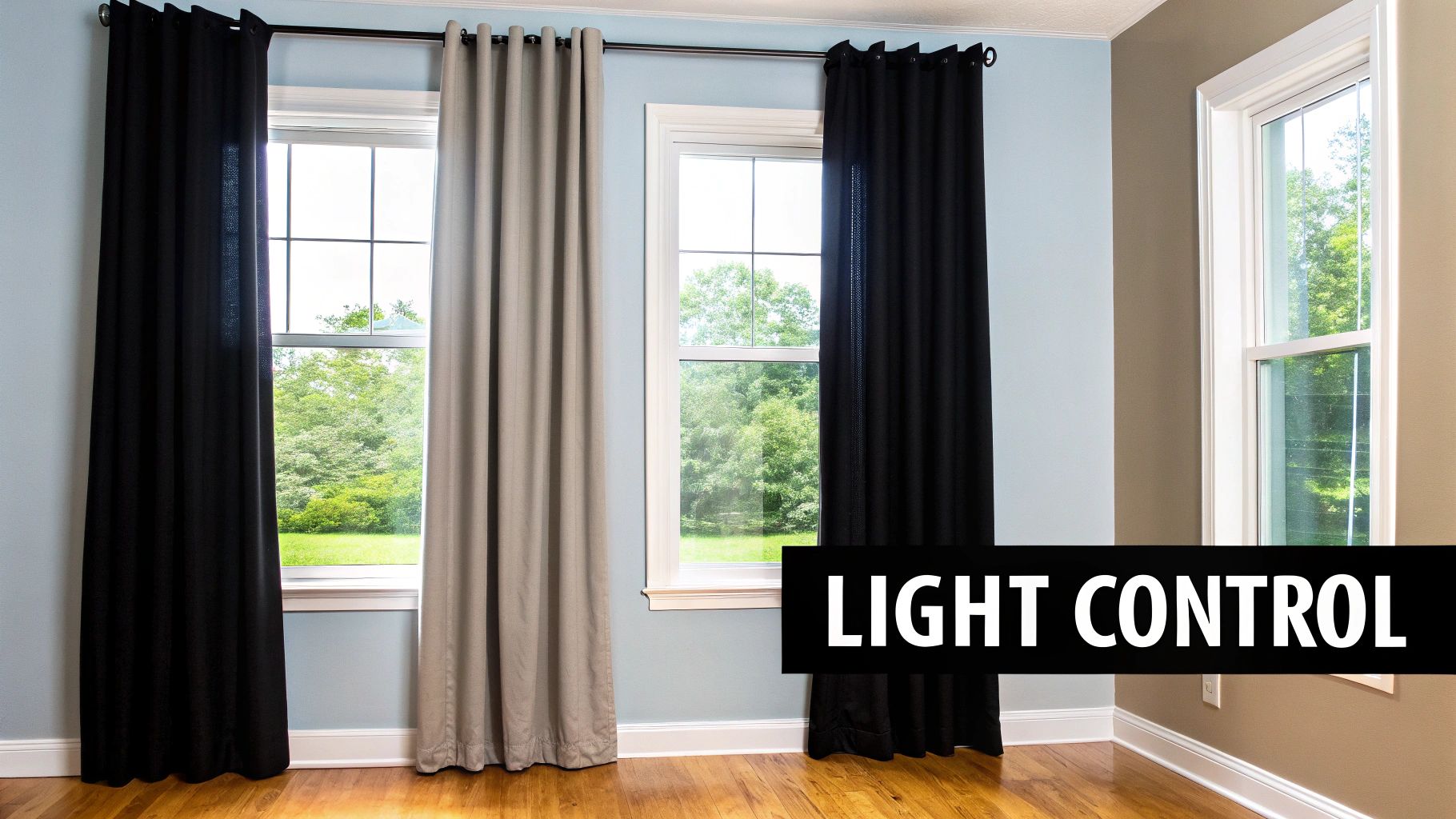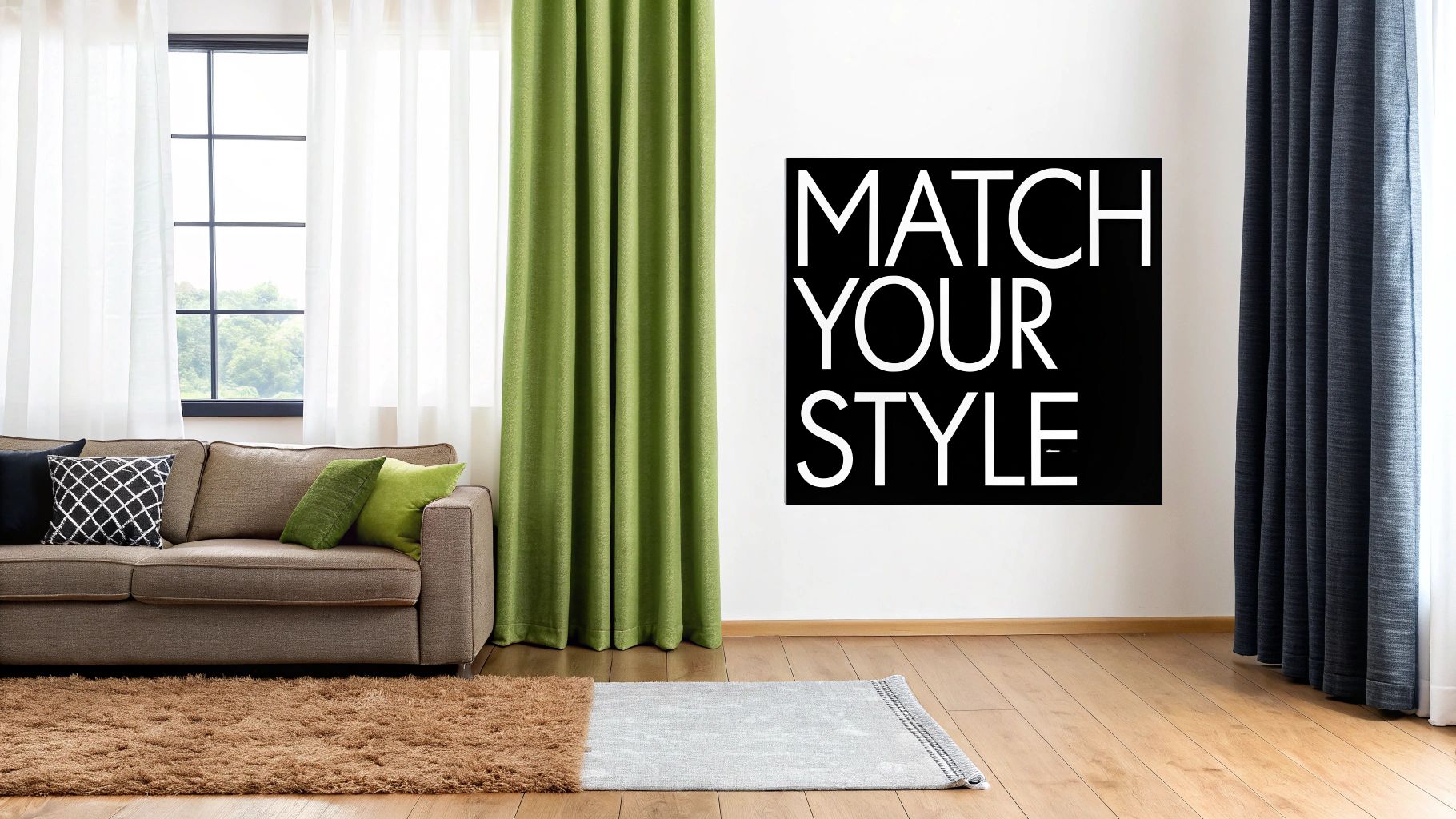
The Ultimate Guide on How to Pick Curtains for a Designer Look
Picking the right curtains is more than just choosing a fabric you love. From my experience helping countless homeowners, the secret is to first match the curtain's function—like light control, privacy, or insulation—to what the room actually needs. Thinking function-first is the key to finding curtains that are not only beautiful but also perfectly practical for your space. This guide on how to pick curtains will walk you through every step.
Table of Contents
- Step 1: Define Your Curtain's Purpose and Function
- Step 2: Measure for Curtains Flawlessly
- Step 3: Choose the Right Curtain Fabric and Material
- Step 4: Select Hardware That Complements Your Curtains
- Frequently Asked Questions
Step 1: Define Your Curtain's Purpose and Function
Before you get lost in a sea of linen and velvet swatches, let's ask a simple question: What is this curtain's main job?
Thinking about function first saves you from the classic mistake of hanging gorgeous but useless window treatments. A sheer, breezy panel might look stunning in a magazine, but it won’t do you any favors against the intense morning sun in your bedroom.

Every room in your home has a different purpose, and the curtains should reflect that. A living room usually benefits from curtains that keep things bright while cutting glare. A bedroom’s top priority, however, is almost always privacy and blocking light for better sleep.
Matching Function to the Room
Let's break down what different spaces need from their curtains. Getting this right will guide your entire selection process.
- Living Rooms: It's all about ambiance here. Light-filtering sheer or semi-sheer curtains are fantastic because they keep the room feeling bright while still offering a bit of privacy. They soften the space without making it feel dark or closed in.
- Bedrooms: Privacy and light control are non-negotiable. Blackout curtains are a go-to choice for a reason. They're designed to block nearly all outside light, giving you total privacy and making them perfect for light-sensitive sleepers.
- Home Offices: Functionality is everything in a workspace. You need to kill screen glare without turning your office into a cave. Room-darkening curtains or high-quality lined drapes are great options, as they block most—but not all—of the light.
- Dining Rooms & Kitchens: These areas call for durable, easy-to-clean fabrics. Light-filtering curtains create a warm, inviting atmosphere for meals, but you'll want to avoid long, puddling styles in high-traffic or potentially messy spots.
Curtain Function Cheat Sheet
To make this even easier, here's a quick cheat sheet to help you match your room's needs with the right curtain function. Think of it as a handy reference to keep your search focused.
| Curtain Function | Primary Purpose | Best For | Common Fabric Types |
|---|---|---|---|
| Light-Filtering | Softly diffuses natural light, reduces glare | Living rooms, dining rooms, kitchens | Sheer, linen, cotton, voiles |
| Room-Darkening | Significantly dims the room, offers privacy | Home offices, media rooms | Tightly woven polyester, thick cotton |
| Blackout | Blocks 99% of light, provides total privacy | Bedrooms, nurseries, home theaters | Foam-backed fabric, multi-layered polyester |
| Thermal/Insulated | Regulates temperature, reduces noise | Drafty rooms, bedrooms, street-facing windows | Lined polyester, velvet, heavy cotton blends |
Understanding Light Control Levels
Once you know the room's purpose, you can pick the right level of light control. This is arguably the most important decision you’ll make when learning how to pick curtains.
Insider Tip: Don’t confuse "room-darkening" with "blackout." Blackout curtains have a special foam-backed lining that blocks 99% of light, creating near-total darkness. Room-darkening curtains dim the room significantly but might still let a faint glow through.
For spaces where you want a soft, diffused glow, light-filtering curtains from JoeyzShopping.com are a perfect fit. For more demanding jobs, take a look at our collection of thermal and blackout drapes. These workhorses not only block light but also help insulate your home. According to the U.S. Department of Energy, proper window treatments can reduce heat loss by up to 25%, helping to lower energy bills.
Step 2: Measure for Curtains Flawlessly
Incorrectly measured curtains can make even the most beautiful fabric look cheap and awkward. The secret to a polished, professional look isn't the price tag—it’s getting your measurements right from the start.
The single most effective trick designers use is to hang the curtain rod higher and wider than the window frame. By mounting the rod several inches above and beyond the window, you create an illusion of a bigger window and a taller ceiling, making the whole space feel more open and grand.
Mastering Curtain Width for Perfect Fullness
First, let's tackle width. Measure the window frame and add 8 to 12 inches (4 to 6 inches on each side). This extra room lets you pull the curtains completely off the glass when open, maximizing natural light.
With your ideal rod width figured out, it's time to calculate how wide your curtain panels need to be.
- Standard Fullness: For a classic drape, your total curtain panel width should be 1.5 to 2 times the width of your curtain rod.
- Luxe Fullness: For a richer, more dramatic feel, go for 2.5 to 3 times the rod width. This looks stunning with heavy fabrics like velvet.
Pro Tip: Always buy curtain panels in pairs. The fullness calculation is based on having one panel on each side of the window for proper coverage and a balanced look.
Choosing the Right Curtain Length
Next is length, which truly defines the style. Measure from where you plan to install the rod down to where you want the hem to end.
The Four Key Curtain Lengths
- Float Length: The hem hangs about a half-inch above the floor. This crisp, clean look is practical for busy areas and makes opening the curtains effortless.
- Kiss Length: The curtains just gently skim the floor. It’s a precise, tailored style that requires spot-on measurements.
- Break Length: The curtains are slightly longer, creating a small, stylish "break" where they meet the floor for a touch of relaxed elegance.
- Puddle Length: This is the most dramatic option. You'll add 6 to 10 extra inches of fabric that pools beautifully on the floor, best for formal spaces where curtains aren't opened often.
Just like it's vital to get curtain measurements right, that same care is needed for other projects. It's the same principle you'd follow when measuring accurately for various home improvements.
Avoiding Common Measuring Mistakes
A few quick checks can save you from common mistakes.
- Use a Metal Tape Measure: A fabric tape can stretch over time, throwing off your numbers.
- Measure Twice, Buy Once: Double-checking every measurement can save you from a costly mistake.
- Account for Hardware: Don't forget how the curtain hangs! Grommet tops sit above the rod, which can change the final hanging length.
For a deeper dive, our complete curtains measuring guide has you covered.
Step 3: Choose the Right Curtain Fabric and Material
You've defined your function and have your measurements. Now for the fun part—choosing the fabric. The material is the heart and soul of your curtains, determining how they hang, play with light, and set the vibe of your room.
The fabric choice is where style and function truly meet. A heavy velvet provides a grand, formal drape that muffles sound, while a light, breezy linen creates a feeling of effortless calm.
Comparing Popular Curtain Fabrics
Getting to know the personality of each fabric will help you make a choice you’ll love for years.
- Linen: For an effortlessly chic, relaxed look. It has a beautiful natural texture, drapes wonderfully, and filters light to create a soft glow.
- Cotton: Versatile and easy to care for, cotton offers a crisp, clean look that can lean modern or traditional.
- Velvet: Nothing says luxury like velvet. Its heavy weight and plush texture make it a fantastic insulator and light-blocker, perfect for creating a cozy, dramatic feel.
- Silk and Faux Silk: For a touch of formal elegance, silk is hard to beat. Faux silk (polyester) gives you a similar look with far more durability.
If you're curious about even more options, our guide on different curtain cloth types is a great resource.
Expert Insight: Remember that a fabric's weight is just as important as its type. Heavier fabrics don't just block more light and provide better insulation; they also absorb more sound—a game-changer if your room faces a busy street.

The Critical Role of Curtain Lining
Lining is the secret ingredient that takes curtains from decorative to highly functional. A separate layer of fabric sewn onto the back, it adds body, improves how curtains hang, and protects the main fabric from sun damage.
Functionally, lining is a powerhouse.
- Light Control: A standard lining adds another barrier to light, but a specialized blackout lining can block nearly 100% of it.
- Insulation: Thermal lining traps air, helping to keep your room warmer in winter and cooler in summer.
- Privacy: It makes even sheerer fabrics more opaque, giving you total peace of mind.

Finding the Perfect Color and Pattern
Your first big decision is whether to go with a solid color or a bold pattern.
If your room already has a lot going on, solid curtains offer visual breathing room. On the other hand, if your room is a sea of neutrals, patterned curtains are a fantastic way to inject personality. When mixing patterns, remember to vary the scale. For great visual examples, you can find tons of design inspiration from a look book.
A Simple Rule of Thumb: When in doubt, pull your curtain color from something already in the room—the wall color, your sofa, a throw pillow, or a piece of art. This creates an instantly coordinated look.
Demystifying Curtain Header Styles
The header is the top part of the curtain that attaches to the rod, and it has a big impact on the overall vibe.
Some of the most common styles you'll run into are:
- Grommet Top: Metal rings punched into the fabric create wide, uniform pleats for a modern, sleek look.
- Rod Pocket: A channel is sewn into the top for the rod to slide through, creating a gathered, casual look.
- Pinch Pleat: Fabric is gathered and stitched into neat, tailored pleats for a classic, formal style.
- Tab Top: Loops of fabric (tabs) along the top give a relaxed, almost cottage-like feel.
Curtain Header Style Comparison
This quick reference table helps match header styles to your room's decor.
| Header Style | Visual Look | Formality Level | Ease of Opening/Closing |
|---|---|---|---|
| Grommet | Wide, soft folds | Casual to Modern | Very Easy |
| Rod Pocket | Gathered, soft | Casual, Informal | Difficult |
| Pinch Pleat | Tailored, structured | Formal, Traditional | Easy (with rings) |
| Tab Top | Flat panels, loops | Casual, Rustic | Moderate |
Step 4: Select Hardware That Complements Your Curtains
Think of curtain hardware as the jewelry for your windows. It’s the essential finishing touch that pulls the whole look together. Choosing the right hardware isn’t just about function; it’s a critical step in elevating your space.
The rod, rings, and finials must work in harmony with your curtains and room decor. A flimsy rod with heavy velvet curtains is a recipe for a sagging, dysfunctional mess.
Choosing the Right Curtain Rod
The curtain rod is the foundation. Its strength and size are everything. For heavier drapes like velvet, look for rods with a diameter of at least 1 inch and add a center support bracket to prevent bowing. Our guide on the best curtain rods for heavy curtains has specific recommendations.
When it comes to length, choose a rod that extends 4 to 6 inches past the window frame on each side. This lets you pull the curtains completely clear of the glass when they're open, maximizing light and making the window feel larger.
Coordinating Finishes and Materials
The material and finish of your hardware should complement existing fixtures in the room, like light fixtures and cabinet pulls.
Here are a few common choices:
- Classic Brass or Bronze: These finishes bring warmth and a traditional feel, pairing beautifully with formal fabrics.
- Matte Black: A versatile and modern choice that offers a striking contrast against light-colored walls.
- Brushed Nickel or Chrome: For a contemporary, clean look, these cool-toned metals are an excellent option.
- Wood: Wooden rods add a natural, rustic, or traditional touch, perfect for cotton or linen curtains.
Expert Tip: Don't be afraid to mix metals, but do it with intention. Stick to two main metal finishes in a room. For example, a matte black curtain rod can provide a modern, grounding contrast to brass light fixtures.
The Impact of Small Details
Finials (the decorative caps on rod ends) and tiebacks are where you can inject personality. Your choice should reflect your room's style: a simple geometric finial for a modern room, or a more detailed design for a traditional space. Tiebacks can be made from matching fabric, rope for a nautical vibe, or metal for a more structured look.
Frequently Asked Questions
Here are direct, clear answers to the most common questions homeowners have when choosing curtains.
How Do I Clean My Curtains?
The short answer is: it depends entirely on the fabric. Always check the care label first, as it is your most reliable guide.
- Cotton & Linen: Many are machine washable on a gentle, cold cycle. Hang to air dry to minimize shrinkage.
- Velvet, Silk, & Lined Curtains: These almost always require professional dry cleaning to avoid damage.
- Polyester & Synthetics: Most can handle a machine wash in cold water and are less likely to shrink.
Insider Tip: For day-to-day upkeep, a quick pass with your vacuum’s soft brush attachment can work wonders to keep dust at bay.
Can I Layer Curtains With Blinds Or Shades?
Yes, absolutely. Layering curtains over blinds or shades is a fantastic design strategy that offers both style and superior light control. Use blinds or shades as your functional base layer for privacy, then add decorative curtain panels on top to bring in color, texture, and softness.
What Should I Do If My Windows Are Different Sizes?
The best way to handle this is to hang all your curtain rods at the same height, regardless of the actual window height. Use the highest window as your guide for all rod placements, and order all your curtains in the same length so they just kiss the floor. This creates a clean, uniform sightline that makes the room feel balanced and intentionally designed.
How Can I Make My Curtains More Child-Safe?
When you have little ones, safety is the top priority. Long, dangling cords are a major hazard. The U.S. Consumer Product Safety Commission has identified corded window coverings as a top hidden danger in the home.
To create a safer environment:
- Go Cordless: This is by far the safest choice for any blinds or shades used under your curtains.
- Secure Your Rods: Mount curtain rods securely into wall studs or with heavy-duty anchors to prevent them from being pulled down.
- Avoid Puddling in Playrooms: In kids' rooms, choose float-length or kiss-length curtains to avoid a tripping hazard.
Feeling ready to find the perfect curtains for your home? At Joey'z Shopping, we offer a wide range of styles, fabrics, and hardware to bring your vision to life. Explore our collections and discover window treatments that perfectly blend style, function, and quality.
